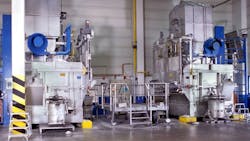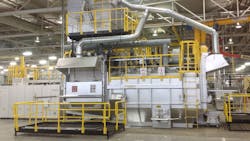Metalcasters are right to be concerned about energy efficiency, but sometimes we see overlook other factors that contribute to the “energy footprint” of a process. So, it’s important to look at optimizing the overall energy costs of a melting shop.
Many foundries will watch Btu/lb. of metal melted, but not always the amount of metal melted to ship one good quality casting. Poor yields or scrapped products mean melting the same metal several times, an unnecessary energy cost and reduction of efficiency. Improving the metal quality to reduce metal-related scrap effectively reduces overall energy consumption.
We believe that melting and holding is a complete interdependent system that should be optimized in its entirety. The drivers for developing state-of-the-art technologies are global.
Energy costs have always been higher in Europe than in North America, and one of the greatest drivers of European energy efficiency. When petrol (gas) costs over $8/gallon, the average motorist is very interested in efficient cars and will accept smaller vehicles/engines as the price for this. But, like everywhere he doesn’t want to pay more for a smaller car, thereby putting pressure on manufacturing costs. This goes directly back to cost-effective, energy-efficient metal handling. International competition is intense in manufacturing, and the competition is no longer just local; the world is getting smaller.
Different peoples of the world also have very different views on what constitutes a good technology. And, different countries have different natural resources, and therefore must be creative with those that are available. Natural gas is not prevalent in many countries, so foundries have learned to deal with furnaces running on propane, butane, oil, diesel, town gas etc. When imported, these are not always cost-effective fuels. This has required some adaptation of technology and operations to get best efficiency; coal-fired crucible furnaces are not as uncommon as one would think!
Metal availability also encourages frugal use of resources, hence the development of newer processes, including the StrikoMelter® shaft furnace technology.
Forces Driving Furnace Development
Quality-management programs -- developed by the Japanese from an American idea and wartime needs for consistency and interchangeability -- were precursors to ISO 9000. Achieving quality goals meant having process capabilities that were both proven and verifiable on a continuous basis.
JIT philosophies are indicative of the drive to find any way to improve quality, while at the same time reduce manufacturing costs. Keeping huge inventories of anything, especially molten metal, became unacceptable. The level of competition, and competitors leapfrogging technology steps, also meant that time and cost to market became important.
European safety and environmental regulations forced significant technology changes in the latter half of the 20th century. European companies were required to produce metal on demand but could no longer tolerate furnaces continuously spewing heat and noxious emissions, and exposing operators to physical danger.
Identifying the usable life of equipment and planning for timely replacements and upgrades ensures that technology continues to develop. Ensuring that new technology projects are not compromised by unrealistic write-off values is a critical planning activity if world-class status is to be maintained.
Achieving significant improvements in melting efficiency is not guaranteed by buying better equipment; there must be a commitment to make it work. This does not necessarily mean more work, but it means there must be a degree of discipline and attention to detail that is beyond nominal.
Correct furnace sizing means having a vessel that accommodates “reasonable” production increases (and not oversized), and will ensure that melting and holding are optimal while still allowing a buffer of capacity for “catch up” situations after cleaning and maintenance. Too big, and a furnace will use additional holding energy; too small and it will be working beyond it’s capacity. An empty shaft means it’s only a holding furnace with no recuperation of energy.
Operating over the rated capacity means inconsistencies in control and no opportunities for maintenance. Charging the optimal ratios of returns and ingot, and ensuring that the shaft is always full and material is available for the next charge, are important disciplines for achieving maximum efficiency. Sizing furnaces according to the available charge material is as important as sizing for melt demand.
Determining the right amount of heat is critical, and often overlooked. Too little heat into the charge and melting will be slow and energy-hungry. Too much heat and excess heat will be lost through exhaust, and dross will be created. Energy input needs to match the charge; multiple smaller burners allow heat input to match energy needs while also distributing it evenly across the melt zone. Oversize burners will not improve melt rate. Burner alignment and positioning is very important to avoid flame impingement. Shorter flames and lower flame speeds prevent direct contact with the charge material, thereby reducing dross formation and metal loss.
Recuperation provides big savings, so keeping the shaft full will maximize heat recovery. Preheating a charge without melting is also important to bring it to a temperature where it is thoroughly heated but the surface is not oxidized. At that point it is possible to “flash” melt quickly with little additional energy input. This will reduce metal loss through oxidation and superheating, and lower hydrogen gas content.
Shaft furnaces address these common, and costly challenges:
• Minimizing expensive molten metal inventories;
• Keeping tap-out volumes flexible, without temperature fluctuations or superheating
• Optimizing bath volume for metal demand
• Providing clean low gas metal without fluxing
How does the StrikoMelter® shaft furnace achieve this? The ETAmax® optimized shaft and melt zone is a culmination of global ideas. The patented shaft design is choked to hold material in the shaft, to absorb the waste heat. Then, it is dispensed in a controlled manner into the melt zone as charge material is melted. When the bath is full, the melt burners stop but the exhaust gasses and heat from the holding bath continue to keep the shaft material at a “ready to melt” temperature. As soon as tapping takes place, the melt burners are activated and melting starts almost immediately.
Efficiency Advantages of Shaft Furnaces
The refractory lining is the heart of a shaft furnace. Geometry is important and the shape and configuration of a melt chamber is critical to energy usage. The lining prevents energy loss through the walls, and provides resistance to metal penetration and erosion. The lining in a shaft furnace is also designed for better efficiency, and therefore better melt quality.
A hot surface is heat loss. Reducing the heat lost through the steel shell is an important energy saving. Using improved insulation materials not only reduces the amount of heat lost but also improves operator safety and comfort. Fans and moving air across your furnace will simply encourage further heat losses.
Metal loss equals energy loss. If dross forms during melting it is an expensive loss of metal as well as of the energy to create it. Additionally, poor casting yields add to energy costs. Why melt more than you need – and then melt it again!
Cleaning furnaces is never easy, nor particularly pleasant. To ensure it’s done, it is necessary to make the job as easy as possible. An internal geometry reachable with manageable tools, no hidden or difficult-to-reach corners, and materials that resist adhesion as long as possible are the keys to making a furnace that is easy to clean regularly and correctly. The new generation of shaft furnace designs have evolved to minimize maintenance and maximize up time.
Long-lasting major components and simple designs using high-quality components that keep inventory costs down without compromising production are characteristic of shaft furnaces.
The most important step toward more efficient melting is a thorough and accurate analysis of current and future melting needs. Not knowing where you are now makes it impossible to plan a route to a successful future. Quantifiable data is needed to identify the opportunities and potential for improvement.
Options for the future will be influenced by a global economy, regardless of individual preferences. This economy is in itself influenced by a whole range of factors that vary from nation to nation, but eventually affect everyone. Benchmarking our processes against ourselves is therefore no longer enough; we must benchmark against the world, and then capitalize on the advantages we have. Foundries everywhere will always be challenged with the availability of the most desired fuels, but the ability to optimize these options with a more efficient furnace technology is now available globally.
Martin Reeves is the managing director, Operations & Technical for StrikoWestofen America, manufacturers of melting and holding furnaces for diecasting, low-pressure casting, sand casting, and permanent mold casting.
About the Author
Martin Reeves
Business Development Advisor
Martin Reeves is the Business Development Advisor with SINC Thermal LLC.

